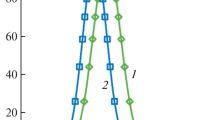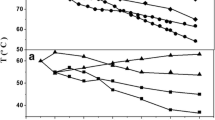Abstract
Inverse microemulsion copolymerization of acrylamide (Am), acrylic acid (AA), and sodium 4-styrenesulfonate (SSS) initiated by redox initiators composed of ammonium peroxodisulphate (APS) and sodium bisulfite, and stabilized by the mixed emulsifier system sorbitan monooleate (Span-80) and polyoxyethylene sorbitan monooleate (Tween 80) were examined as a function of the combination of hydrophilic (Tween 80) and hydrophobic (Span 80) emulsifiers, reaction temperature, AM/AA mass ratio, SSS concentration, and initiator concentration. The physicochemical and thermal properties and the structure of this copolymer were also determined and discussed. The reaction rates for all runs of the experiments exhibited two intervals, which were typical of microemulsion polymerization. The copolymer had only one glass transition temperature of 115.5 °C, indicating a random structure.









Similar content being viewed by others
References
He GW, Pan QM, Rempel GL (2003) Synthesis of poly(methyl methacrylate) nanosize particles by differential microemulsion polymerization. Macromol Rapid Commun 24:585–588
Chen J, Zhang ZC (2007) Radiation-induced polymerization of methyl methacrylate in microemulsion with high monomer content. Eur Polym J 43(4):1188–1194
Lim TH, Tham MP, Liu ZL, Hong L, Guo B (2007) Nano-structured proton exchange membranes molded by polymerizing bi-continuous microemulsion. J Membr Sci 290(1–2):146–152
Katime I, Arellanoa J, Schulz P (2006) Poly(n-hexyl methacrylate) polymerization in three-component microemulsion stabilized by a cationic surfactant. J Colloid Interface Sci 296:490–495
Barton J, Capek I (2000) Acrylamide and butyl acrylate polymerization in Winsor IV (w/o) and Winsor I (o/w) microemulsions. Macromolecules 33:5353–5357
Renteria M, Munoz M, Ochoa JRL, Cesteros C, Katime I (2005) Acrylamide inverse microemulsion polymerization in a paraffinic solvent: Rolling-M-245. J Polym Sci Part A Polym Chem 43:2495–2503
Candau F, Pabon M, Anquetil JY (1999) Polymerizable microemulsions: some criteria to achieve an optimal formulation. Colloids Surf A Physiochem Eng Aspects 153:47–59
Barton J, Juranic˘ova V (2000) Polymerization of acrylamide in styrene containing inverse microemulsions: polymerization kinetics and polymer product composition studies. Polym Int 49:1483–1491
Barton J, Kawamoto S, Fujimoto K, Kawaguchi H, Capek I (2000) Preparation of partly hydrophobized, crosslinked polyacrylamide particles by terpolymerization of acrylamide/N, N-methylenebisacrylamide/styrene in inverse microemulsion. Polym Int 49:358–366
Sanz FJE, Gomez JRO, Sasia PM, Apodaca ED, Ri’o P (2007) Synthesis of cationic flocculants by the inverse microemulsion copolymerization of acrylamide with 60% 2-acryloxyethyltrimethyl ammonium chloride in the monomer feed. I. Initiation by ammonium persulfate/sodium disulfite redox system. J Appl Polym Sci 103:2826–2836
Ochoa JR, Sanz FJE, Sasia PM, Garcı’a S, Apodaca ED, Ri’o P (2007) Synthesis of cationic flocculants by the inverse microemulsion copolymerization of acrylamide with 60% 2-acryloxyethyltrimethyl ammonium chloride in the monomer feed. II. Influence of the formulation composition, hydrophilic-lipophilic balance, starting polymerization temperature, and reaction time. J Appl Polym Sci 103:186–197
Kaneda I, Sogabe A, Nakajima H (2004) Water-swellable polyelectrolyte microgels polymerized in an inverse microemulsion using a nonionic surfactant. J Colloid Interface Sci 275:450–457
Wan T, Wang L, Yao J, Ma XL, Yin QS, Zang TS (2008) Saline solution absorbency and structure study of poly (AA–AM) water superabsorbent by inverse microemulsion polymerization. Polym Bull 60:431–440
Lopez RG, Trevino ME, Peralta RD, Cesteros LC, Katime I, Flores J (2000) A kinetic description of the free radical polymerization of vinyl acetate in cationic microemulsions. Macromolecules 33(8):2848–2854
Paril A, Alb AM, Giz AT, Catalgil GH (2007) Effect of medium pH on the reactivity ratios in acrylamide acrylic acid copolymerization. J Appl Polym Sci 103(2):968–974
Rintoul I, Wandrey C (2005) Polymerization of ionic monomers in polar solvents: kinetics and mechanism of the free radical copolymerization of acrylamide/acrylic acid. Polymer 46:4525–4532
Nowakowska M, Zapotoczny SZ (1996) Polymeric photosensitizers. 3. Determination of the copolymerization parameters for N-vinylcarbazole and sodium styrene-sulfonate. Polymer 37:5275–5282
Dubinsky SD, Grader GS, Shter GE, Silverstein M (2004) Thermal degradation of poly(acrylic acid) containing copper nitrate. Polym Degrad Stab 86:171–178
Bozkurt A, Meyer WH, Gutmann J, Wegner G (2003) Proton conducting copolymers on the basis of vinylphosphonic acid and 4-vinylimidazole. Solid State Ionics 164:169–176
McNeill IC, Ahmed S, Memetea L (1995) Thermal degradation of vinyl acetate-methacrylic acid copolymer and the homopolymers. II. Thermal analysis studies. Polym Degrad Stab 48(1):89–97
Lazzari M, Kitayama T, He S, Hatada K, Chiantore O (1997) The effect of stereoregularity on the thermal behavior of poly(methacrylic acid)s: I. Thermal analysis studies. Polym Bull 39(1):85–91
Lazzari M, Kitayama T, Hatada K, Chiantore O (1998) Effect of stereoregularity on the thermal behavior of poly(methacrylic acid)s. 2. Decomposition at low temperatures. Macromolecules 31(23):8075–8082
Xue TJ, Wilkie CA (1997) Thermal degradation of poly(styrene-g-acrylonitrile). Polym Degrad Stab 56:109–113
Acknowledgments
The authors gratefully acknowledge the financial support of China Postdoctoral Science Foundation (No. 20070421140).
Author information
Authors and Affiliations
Corresponding author
Rights and permissions
About this article
Cite this article
Wan, T., Zang, T., Wang, Y. et al. Preparation of water soluble Am–AA–SSS copolymers by inverse microemulsion polymerization. Polym. Bull. 65, 565–576 (2010). https://doi.org/10.1007/s00289-009-0234-9
Received:
Revised:
Accepted:
Published:
Issue Date:
DOI: https://doi.org/10.1007/s00289-009-0234-9




